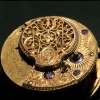Vienna Regulator
-
Recently Browsing
- No registered users viewing this page.
-
Topics
-
Posts
-
By Neverenoughwatches · Posted
Same question that was asked last time Hakan, and emphasis was placed on it. It was ignored. The thread should still be there, if not I have a copy of his reply. -
This is probably the single most important point. One of my best friends, 48 years old at the time, suffered a massive stroke about 15 years ago. He barely survived, but his life was never the same after that. If you had asked me back then to guess which of my friends might have a stroke and nearly die, he would have been the very last one I'd have picked. He was perfectly healthy, played tennis three times a week, ran a successful business, was full of life, and had a wonderful wife and well-behaved teenage kids. The harsh truth is, we never know when it’s "game over." @Mark, I truly wish you a long, happy, and successful life. But have you given any thought to some kind of backup plan for WRT in case the worst should happen? Is there anyone who could keep the site going? If you can reassure us in some way, it would mean more than a lot to us!
-
By luiazazrambo · Posted
Update: The demagnetization only helped temporarily, maybe it pulled the wheels into a position where they liked each other. I have to adjust the sub second hand as it is a bit angled upwards and catching the minute hand stopping the whole movement but before this happened there were some wild deviations. HWGIKE#58 Alarm clock, cooked in hot cleaning fluid and oiled gently. This is a movement so I count it. 🙂 A while ago it tried to fly away one day, it was on my windows sill, we had strong wind the curtain flew like a flag and doing so encouraged my clock to do the same... went out and ended up on the roof above the entrance door, its door in pieces but the clock itself suffered no damage otherwise. The original glass was already broken when I received it I still have the bottom part in two pieces. The new "glass" is acrylic. It also had a paper in the back in the case inside but it disintegrated, I still have a little bit of piece of that too. HWGIKE#59 Durowe 870 / Times M84 This particular instance is a D870, when I saw its worn out contact pin I thought that it must be a design flaw, and here we go: https://17jewels.info/movements/d/durowe/durowe-870/ An incredible movement again where the balance wheel drives the train and has two magnets one for the balance wheel/coil and one for the pallet. The magnet for the pallet is basically the "draw" one direction. The coil is about 1.8kOhm and one end is in contact with the main plate and the other end is soldered to a contact pin which is insulated by the means of putting it into a jewel and this contact pin is rubbing against a wire getting the energy/impulse as it is passing. Behind the contact pin there is an "impulse jewel" not sure why is it there... the wire seems to hit the impulse jewel first then the contact pin but maybe it is there only for insulation purposes? I was almost certain that the screw holding down the battery - (minus) clamp had no insulation washer.. i only noticed the green stuff around it coming from battery leakage... anyway the + and - had a shortcut which took me a while to realize.. had to fabricate one insulating washer on my own. The jewel settings were dirty but not it is all cleaned and oiled. The contact pin might work for a while but I am sure it has a short life. It is a front loader the whole thing is held together by the case so it is not possible to regulate it without putting it all together and taking the movement out of the case again, very inconvenient. A wonderful movement but not made for eternity only for the consumer market. -
Is it a crystal or an acrylic and just foggy with age?
-







Recommended Posts
Join the conversation
You can post now and register later. If you have an account, sign in now to post with your account.
Note: Your post will require moderator approval before it will be visible.